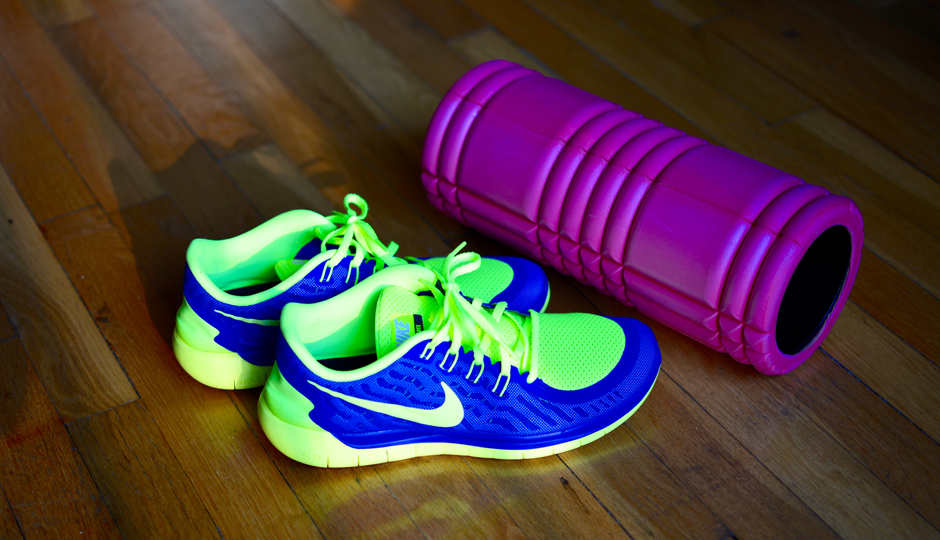5 Tips to Get the Most Out of Your Foam Roller
Sure, we’re all obsessed with our boutique Flywheel, CorePower and SoulCycle classes, but there is one less-glamourous (more budget-friendly) activity that can make a huge difference in your body — and help you get more out of those fancy classes: Foam rolling.
Foam rolling, also known as self-myofascial release, is a technique designed to work out the knots in your muscles. It is similar to a sports massage and can provide many benefits for overall muscle health. Foam rolling has been shown to be helpful in addressing a variety of conditions, like IT band syndrome, patellofemoral pain syndrome (runner’s knee), shin splints, low back pain, infrapatellar tendinitis (jumper’s knee), blood flow and joint range of motion. Foam rollers come in many shapes, sizes and firmness depending on your individual needs.
Here are 5 foam rolling tips that will help you get the most out of your foam roller. Let’s get rolling! (Sorry, I couldn’t help myself.)
1. Roll pre-workout.
Foam rolling is often thought of as a post-workout activity, but you can improve your workouts by giving your muscles some TLC with a foam roller before you start working out, too. This will help prepare your muscles to work to their fullest potential. When your muscles work more efficiently, you can push harder and as a result burn more calories during a workout. This can also help to loosen up tight areas, improving mobility and range of motion.
Going over the quadriceps with the foam roller is a great pre-workout exercise to start with, since your quads are the largest and most widely used muscles in the lower body. Here’s how it goes: Place the roller perpendicular to one leg and lie over it, with your hands supporting your body like you would in a high-plank position; the pressure should be on the thigh. Find a spot and hold your bodyweight on it for several seconds to help the tissue release. Use the weight of your upper body to roll the roller to different sore spot on the upper leg; Try to keep the core engaged so the lower back does not arch too much.
2. Slow your roll.
Lightly rolling or rolling too quickly won’t have much of an effect, so make sure you put some pressure into those target areas by positioning yourself effectively before you slowly roll around the tender areas for 30 to 60 seconds. Note: If you are new to foam rolling, start off with a softer foam roller and slowly progress to a firmer one.
3. Avoid the lower back.
One area to avoid direct foam rolling is up and down the lower back. Instead, position the foam roller parallel to the spine to target the upper-and mid-back and muscles of the buttocks area. By loosening up other muscles surrounding the lower back, you can dramatically decrease pain and increase mobility.
4. Listen to your body.
It is important to listen to the feedback your body is giving you and to use this as a guide for when to go deeper and when to simply back off. In the beginning, rolling will most likely feel uncomfortable, so start with small doses and aim for five to 10 minutes a day. Also, try to ease into the process to help prevent excessive soreness or injury.
5. Relax and keep breathing.
One of the most important components of successful foam rolling is good breathing and staying relaxed. Sometimes foam rolling can be rather painful (discomfort will reduce with frequency, but also take note of #4). Holding your breath causes unnecessary muscle tension, making it harder to reach the trigger points that are causing problems. Try to use this time as you would for a regular deep tissue massage and let your mind relax.
The key with foam rolling is to stay consistent and practice, practice, practice! Your body will thank you in the long run and over time the tight muscle areas will improve. Always remember to drink plenty of water after a session which will help speed up the recovery process. Happy rolling!
Robyn Weisman is a Philadelphia-based personal trainer and corrective exercise specialist and owner of Results by RW (in-home and on-site training). She specializes in general fitness, injury prevention, post-rehabilitation, muscular imbalances and using corrective exercise as an exercise alternative for pain relief. Robyn offers a variety of packages aimed towards each individual’s specific goals to help improve their overall health and fitness and lead a healthier lifestyle.
Like what you’re reading? Stay in touch with Be Well Philly—here’s how:
- Like Be Well Philly on Facebook
- Follow Be Well Philly on Twitter
- Follow Be Well Philly on Pinterest
- Get the Be Well Philly Newsletter



